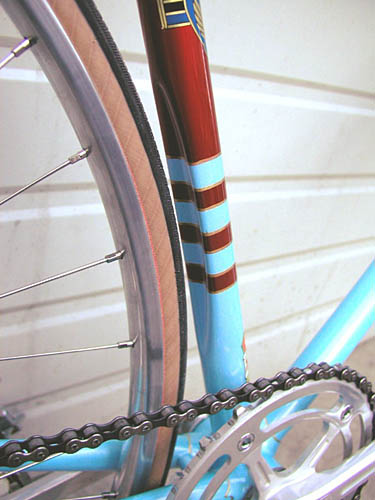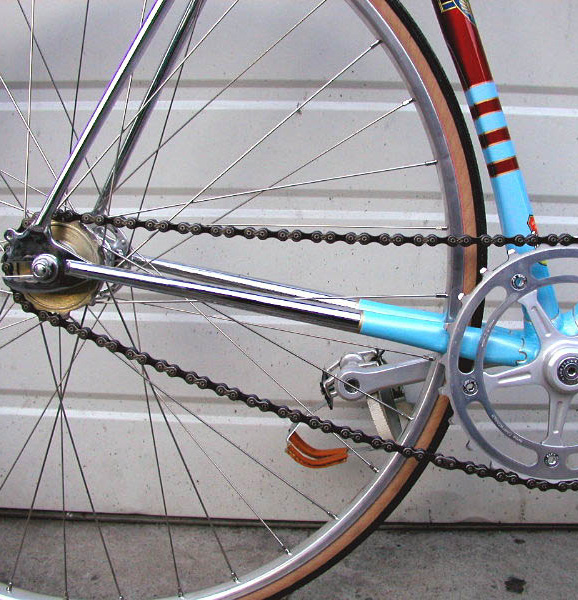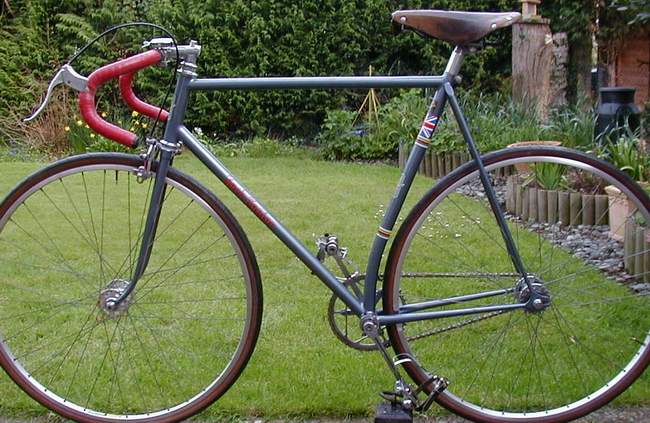Vol. 2, Issue 80 - March / April 2019
Posted: Saturday 16th March 2019
Historically, late forties – early fifties, many cycle shops also sold radio sets to help trading during the winter. A by-product of this was that many sets were battery operated, having two batteries, one of which was an accumulator providing a steady low amperage to the valves alongside another more conventional battery to power the rest of the unit. These accumulators (think small car battery in a glass container) needed a long slow charge every so often and owners would keep two of them, using one while having the other charged. Cycle/radio shops often provided an accumulator charging service which would consist of masses of accumulators linked together (in series?) with either end connected to the charger.
In Cambridge we have a Robinson College as part of the university with a tenuous link to all of this. The benefactor, David Robinson’s father had a cycle/radio shop and David started his working life with him in the 1930’s. To cut a very long story short David Robinson’s empire started in the cycle/radio shop and progressed via the radio side of the business to TV from which the Robinson name was connected to a nationwide TV rental business that made the family fortunes. As a benefactor David Robinson funded the building of a new college and also the maternity wing at Cambridge University Hospitals, not all from charging accumulators though.
I had Frank build me two frames. One a track frame which sadly I no longer have. The other is a road frame which I still have. No. 6406. I think I purchased this c. 1964 so it suggests that his frame is the sixth built in 1964. It has a 23 inch seat tube which is now a touch too small as I grew somewhat after I was 16.
I well remember visiting Frank’s shop in Markhouse Road and being served by Frank’s wife. Frank came out of his workshop occasionally.
Peter will be sending more of his reminiscences in due course.
We recently showed an image of a rare Rondinella short-wheelbase bike with twin seat tubes being used for time trials. There was a time when several builders produced such machines which I assume were mainly used by time-triallists as they are very rarely seen on the track. Methods to get the wheelbase down to about 39” from the more usual 40” plus were varied. In 1949 R O Harrison produced the Shortwin with twin downtubes allowing the seat tube to be canted forward and anchored between them in front of the bottom bracket as this page from their 1949 catalogue shows. I once owned one of these and going at speed downhill on fixed wheel was quite a twitchy ride as the rear end felt as if it wanted to overtake the front. Apart from this the ride was quite responsive although a little harsh.

Hetchins built a frame shown below with the seat tube indented/fluted and this, coupled with track ends, managed to achieve the magical 39” wheelbase. ‘6 day’ was added to a model name by Hetchins to denote this SWB build, hence ‘Experto Crede 6-day’, an Experto Crede frame with the 6-day modification.


Jack Taylor was famous for the curved seat tube, seen below, and I even saw one built as a touring frame built by them. I imagine it would be a very twitchy ride with panniers, especially at speeds downhill! This would also make heel room quite tricky with panniers fitted, which is probably why they produced two rack configurations, one ‘cranked’ to cater for this.
As with all hand-built machines, they would build what the customer asked for but most tourists would opt for a slightly longer wheelbase than normal for built-in stability when loaded.
Bob Freeman tells us that he has a Jack Taylor curved tube, but it is a longish wheelbase due to the shallow front end and lots of fork rake. And the rear certainly could have been shorter.
Many of these SWB machines had track ends although a few had forward-facing road ends. It is obvious that a frame built to tuck the rear wheel as far forward as possible would work better if the wheel could be taken out backwards rather than having to allow space for it to move forwards, the Jack Taylor above shows this in some detail. The advent of vertical rear dropouts obviated this problem of course.
Trevor Jarvis approached this concept in a completely different way with his Flying Gate model. Here is one owned by Bob Freeman who tells us that the wheelbase is 38 3/8” which is the shortest he knows of.
Viking were one company who went to extremes to reduce the wheelbase to 39 ½” with their SBU Tracker produced in the early 1950s.
More details at https://www.classiclightweights.co.uk/bikes/viking-sbu-rb.html
I don’t know what their designers had in mind, but it certainly wasn’t minimal elegance. Their brochure states: “SBU (Short-Wheelbase Underslung) design was arrived at after extensive research into lateral and torsional twisting stresses. As you can see, there are two pairs of chainstays, an upper and a lower, and the down tube extends down beyond the bottom-bracket for an estimated 28cm.” Viking state that “The SBU separates the two stresses and concentrates each at a different point”.
The first version of this frame did not have the ‘upper’ chainstays which were added when it was discovered that the frame lacked lateral stiffness when used on the track. Well there’s a surprise, who would have thought it?
Cyclists in the late 40s and 50s spent most of their time talking about frame measurements and angles. I knew of one who had his follow-up machine built with an extra 1/8” for rake! To measure the wheelbase the correct formula is from centre of front dropout to the rear dropout where an extension of the seat stay would intersect it.
The springs in these levers are more correctly referred to as ‘drag springs’; they are directionally wound around a drum such that when you pull the lever back, (downshift RD) the spring opens up slightly and slips around the drum. However, when the lever is pushed away from you (upshift RD) the spring tightens around the drum, and the drum moves against a standard friction clutch. (Capstans on boats grip ropes in a similar way to how a drag spring works).
Hence the downshift friction is low, and the upshift friction is adjustable (as per a normal friction lever). Cunningly (and in complete contrast to standard friction levers), because the friction clutch is only ever driven in one direction, it tends not ever to loosen, even if the first washer (with two flats on it) becomes a slack fit on the dummy boss.
I have another two variants of the levers:
1) a Simplex retrofriction lever with a solid end (i.e. without the loop in it) and the Simplex ‘star’ logo in it and
2) the usual open loop type, but with ‘Spidel’ branding rather than Simplex. In about 1985 or 1986 ‘Spidel’ branded groupsets were produced, which appear to comprise Stronglight cranks, CLB brakes, Simplex gear levers, Huret derailleurs ( I think), Maillard freewheel hubs, Sedis chain etc all branded with ‘Spidel’ markings.

When I was wandering around England looking for someplace to learn frame building I stopped in Jim Harrison’s shop in Manchester. By chance I discovered his birthday was the same as mine on July 7. I don’t remember much about what he told me of his history and somewhere just recently I read his shop got fire bombed in 1981 and he never fully recovered the business after that. Oh that was in a letter Ron Sant sent me before Ron passed away. Anyway, he is one of the missing frame builders in your excellent list of British builders and thought I should mention him in case more information could be found.
Would Peter Russell please contact Julian as he would like to ask about Eltham Paragon? Julian had read your piece in Lightweight News 58.
Reading about feeding stations in the latest edition of Classic Lightweight News put me in mind of drinks that we enjoyed as children in the 1960’s. We regularly drank concoctions of milk and cream soda or milk and ginger beer. Both mixed 50/50 using whole milk and Tullet’s brand fizzy drinks. They may sound disgusting but are surprisingly pleasant and refreshing.
My father (now aged 90) recently related this to me:
Between the wars my grandfather owned a cafe situated on the ‘Epping New Road’ near the Reindeer public house (now demolished). This section of road ran from Bancroft’s School, Woodford, (a regular meeting point for club cyclists) and the Wake Arms PH near Loughton. It was a very popular route for cyclists from East London. Starting points included Whipp’s Cross, The Castle public house and Bancroft’s School (both in Woodford) with destinations being Chingford (Connaught Waters & Rigg’s Retreat), High Beech (very popular), Epping, Harlow and beyond.
The Grange Cafe was a regular stop for cyclists. My father recalls thousands of cyclists passing through back in the 1930’s, sometimes so many that it was nearly impossible to cross the road. The Grange was very busy at weekends serving cyclists with these ‘energy drinks’ in pint glasses. It was also the meeting place for two clubs. One was the Rodley Wheelers, the other unknown. They used to have their club dinners in the room above the cafe using a snooker table with the cover boards on for a dining table.
After the war trade began to diminish and my grandfather moved to a new location in Loughton. In the 1950’s the destinations frequented by cyclists became favoured by motorcyclists, particularly High Beech and The Wake Arms PH.
I also recall seeing an advertisement in an early 1950’s copy of ‘Cycling’ by the Milk Marketing Board promoting the virtues of drinking Milk and Cream Soda as an energy drink !
I wonder if any reader can tell me anything about The Rodley Wheelers. I have seen mention of them in ‘Cycling’ but would love to know more.
I am currently resorting a F H Scott ‘ Dragon’. I picked up the frame which I believe to be a ‘Scott Special Continental Model’ with Nervex Pro lugs, made sometime in the 1950’s. It was in a sorry state stripped of all equipment. I’ve been collecting period parts over the last year and hope to have it back on the road by the summer. On researching Mr Frederick Henry Scott, I soon found that very little information is available, something I find a little frustrating for a man who was in business for around 50 years! I hope to venture west to the Ealing local history library to see if any information can be found within. The few facts about him I have are:
Born c1889
c1911 trained at Chater Lea ?
1911 he is described as a tinsmith, at 59 Murray Road.
1912-1936 Cycle dealer and cycle maker, of 59 Murray Road, takes over tandem production for Charter Lea
1936-1964 Scott’s Cycles at 163 and 165 South Ealing Road
WANTED!! The Harry Perry bike I traded in at John Pavey’s Hardwick in 1991. Frame was red with black lettering in white lozenges. IT IS OUT THERE SOMEWHERE!!
Posted: Saturday 16th March 2019
This article appears in the following categories.
Upcoming Events
Whether you are looking for a gentle social meet up, or a 100-mile ride browse the community’s upcoming events and plan your next weekend outing.




